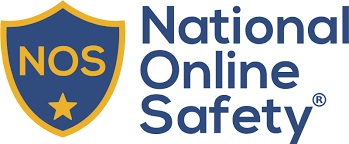Online Safety
What is Online Safety?
Internet or Online Safety encompasses not only online technologies but also electronic communications via mobile phones, games consoles and wireless technology. It highlights the need to educate children and young people about the benefits, risks and responsibilities of using information technology.
Online Safety:
- concerns safeguarding children and young people in the digital world.
emphasises learning to understand and use new technologies in a positive way. - is less about restriction and more about education about the risks as well as the benefits so we can feel confident online.
- is concerned with supporting children and young people to develop safer online behaviours both in and out of school.
National Online Safety Posters
DFE Teaching Online Safety in School 2019
Our Online Safety Curriculum


Our Online Safety curriculum is linked to PHSE and the UKCIS Educated for a Connected World document. We use the National Online Safety and Project Evolve resources to teach children about how to behave safety online and provide them with strategies to deal with inappropriate behaviour they might experience whilst using the Internet.
UKCIS Education for a Connected World
GOV.UK Useful Tips For Staying Safe Online
Stay Connected
By following guidance on social distancing and staying at home you are helping to protect yourself, your family, the NHS and your community.
It is still important to stay connected with family and friends. Staying in touch with people you normally see often or reconnecting with old friends by phone, video call or social media can boost wellbeing. The BBC has guidance on how to video call your family and friends.
The internet also offers people a wide range of educational resources, information and entertainment.
We also have additional advice for parents and carers.
Stay Safe
Many people are using new services, apps or devices, such as webcams and tablets, to work or socialise at this time. You may also be using existing devices and services more often.
To help you stay safe:
- Check your security and privacy settings
- Block unsuitable content
- Protect against fraud
Check the Facts
Not all information online is reliable.
Before you like, comment or share something online use the SHARE checklist to make sure you’re not contributing to the spread of harmful content:
- Source – make sure information comes from a trusted source.
- Headline – always read beyond the headline.
- Analyse – check the facts.
- Retouched – does the image or video look as though it has been doctored?
- Error – look out for bad grammar and spelling.
SHARE can help you understand and spot disinformation and NewsGuard has a free tool to help the public identify fake news.
You can also check claims about COVID-19 at Full Fact.
Ofcom also has Cutting Through the COVID-19 Confusion.
Reliable information on COVID-19 can also be found at www.gov.uk/coronavirus.
Advice For Parents and Carers
It is important for children and young people to stay both connected and safe online. Remember to make use of parental controls and to talk with your children.
The UK’s Chief Medical Officer has also provided advice on screen time. Here are a few of the tips to help your children strike a balance:
Sleep Matters
Getting enough good quality sleep is very important. Leave phones outside the bedroom when it is bedtime.
Sharing Sensibly
Talk about sharing photos and information online and how photos and words are sometimes manipulated. Parents and carers should never assume that children are happy for their photos to be shared. For everyone – when in doubt, don’t upload!
Talking Helps
Talk with children about using screens and what they are watching. A change in behaviour can be a sign they are distressed – make sure they know they can always speak to you or another responsible adult if they feel uncomfortable with screen or social media use.
Keep Moving!
Everyone should take a break after a couple of hours sitting or lying down using a screen. It’s good to get up and move about a bit. #sitlessmovemore
Family Time Together
Screen-free meal times are a good idea – you can enjoy face-to-face conversationalist, with adults giving their full attention to children.
Use Helpful Phone Features
Some devices and platforms have special features – try using these features to keep track of how much time you (and with their permission, your children) spend looking at screens or on social media.
For more information and useful links from the Government use the link below:
Online Safety Tips for Children
All of our classes and parents took part in a Be Internet Legends online safety assembly with schools from around the country. We learned how to become repsonsible digital citizens using the words: Sharp, Alert, Secure, Kind and Brave.
Why not take a look at some of the great resources available below to support your child at home!
Be Internet Legends Parent Zone
Barefoot Computing Home Learning
Online Safety Tips for Children
Social Media Age Restrictions
Below are recommended ages to use certain social media sites:
| Social Media | Age Limit | Additional Information |
| Snapchat | 13+ years | If under 13 then there is a kids version called Snapkidz. A software called mSpy allows parents to see what their children are sending on Snapchat, as well as who they’re calling, texting, emailing and where they are. Parents download the software onto their child’s phone first. |
| Instagram / Facebook | 13+ years | If you let younger children use the app it may expose your child to photos and videos that they aren’t old enough to understand. |
| 13+ years |
13+ years Higher age limit as users allowed to access contact details. |
The SMART Rules
At Our Lady of Lourdes, we use the SMART rules (Childnet.com) to help children understand how to keep themselves safe whilst using the Internet. Every year, we also have a competition to design a SMART poster and each class chooses a winner. These posters are then displayed in the ICT Suite.
